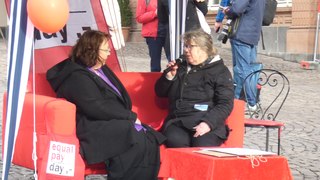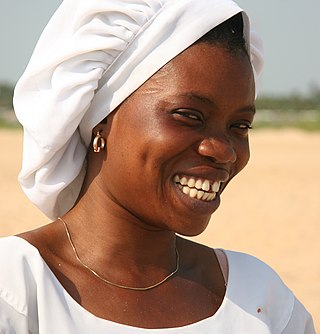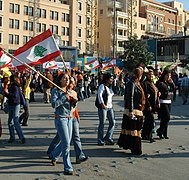Gender equality, also known as sexual equality or equality of the sexes, is the state of equal ease of access to resources and opportunities regardless of gender, including economic participation and decision-making; and the state of valuing different behaviors, aspirations and needs equally, regardless of gender.

Since the industrial revolution, participation of women in the workforce outside the home has increased in industrialized nations, with particularly large growth seen in the 20th century. Largely seen as a boon for industrial society, women in the workforce contribute to a higher national economic output as measure in GDP as well as decreasing labor costs by increasing the labor supply in a society.
Gender inequality is the social phenomenon in which people are not treated equally on the basis of gender. This inequality can be caused by gender discrimination or sexism. The treatment may arise from distinctions regarding biology, psychology, or cultural norms prevalent in the society. Some of these distinctions are empirically grounded, while others appear to be social constructs. While current policies around the world cause inequality among individuals, it is women who are most affected. Gender inequality weakens women in many areas such as health, education, and business life. Studies show the different experiences of genders across many domains including education, life expectancy, personality, interests, family life, careers, and political affiliation. Gender inequality is experienced differently across different cultures.

The roles of women in Lebanon have evolved throughout history. The legal status of women transformed over the 20th century, but traditional patriarchal norms and conservative versions of Islamic law continue to influence women's rights in Lebanon.
According to Human Rights Watch, there is substantial discrimination against women in the United Arab Emirates. The status of women has improved over the years. UAE performs better on metrics of gender equality than many other states in the Gulf region, and it has been making reforms to protect women's rights and empower women in different sectors. Critics describe some of these reforms as window dressing.
Gender inequality in India refers to health, education, economic and political inequalities between men and women in India. Various international gender inequality indices rank India differently on each of these factors, as well as on a composite basis, and these indices are controversial.
The Social Institutions and Gender Index (SIGI) is an index that measures discrimination against women. It solely focuses on social institutions which are formal and informal laws, social norms and customary practices that impact the roles of women. The SIGI is a multifaceted measure that focuses on four dimensions: Discrimination in the family, Restricted physical integrity, Restricted access to productive and financial resources, and Restricted civil liberties.
The United Nations Entity for Gender Equality and the Empowerment of Women, also known as UN Women, is a United Nations entity charged with working for gender equality and the empowerment of women. UN Women is charged with advocating for the rights of women and girls, and focusing on a number of issues, including violence against women and violence against LGBT people.
The OECD Gender, Institutions and Development (GID) Database, or GID-DB, contains more than 60 data indicators of gender equality. The GID-DB was introduced in 2006 by the OECD Development Centre to provide a data tool to help researchers and policy makers determine and analyze obstacles to women's social and economic development. It provides these gender-related data for up to 162 countries from Afghanistan to Zimbabwe, thereby covering all regions and country-income-categories of the world.

The Gender Inequality Index (GII) is an index for the measurement of gender disparity that was introduced in the 2010 Human Development Report 20th anniversary edition by the United Nations Development Programme (UNDP). According to the UNDP, this index is a composite measure to quantify the loss of achievement within a country due to gender inequality. It uses three dimensions to measure opportunity cost: reproductive health, empowerment, and labor market participation. The new index was introduced as an experimental measure to remedy the shortcomings of the previous indicators, the Gender Development Index (GDI) and the Gender Empowerment Measure (GEM), both of which were introduced in the 1995 Human Development Report.
In South Korea, gender inequality is derived from deeply rooted patriarchal ideologies with specifically defined gender-roles. While it remains especially prevalent in South Korea's economy and politics, gender inequality has decreased in healthcare and education.

The gender pay gap or gender wage gap is the average difference between the remuneration for men and women who are working. Women are generally found to be paid less than men. There are two distinct numbers regarding the pay gap: non-adjusted versus adjusted pay gap. The latter typically takes into account differences in hours worked, occupations chosen, education and job experience. In other words, the adjusted values represent how much women and men make for the same work, while the non-adjusted values represent how much the average man and woman make in total. In the United States, for example, the non-adjusted average woman's annual salary is 79–83% of the average man's salary, compared to 95–99% for the adjusted average salary.

Women in Benin have gained more rights since the restoration of democracy and the ratification of the Constitution, and the passage of the Personal and Family Code in 2004. These both overrode various traditional customs that systematically treated women unequally. Still, inequality and discrimination persist. "Girls from the age of five or so are actively involved in housekeeping, sibling care, and agriculture." Society could think about of a woman's role are a housemaid, caretaker, or babysitter. A woman's role is to be a housemaker and nothing at all, but women have much potential to be more than a housemaker. With laws taking charge of what a woman can be as a career of how they are being useful more in the house than in a men's job position. Moreover, these rules apply to women by their gender that has not changed for a while. And there has been inequality based on being the opposite gender which these rules should immediately change if the society wants to get better to have equality for the female race.
The evolution and history of women in Asia coincide with the evolution and history of Asian continent itself. They also correspond with the cultures that developed within the region. Asian women can be categorically grouped as women from the Asian subregions of Central Asia, East Asia, North Asia, South Asia, Southeast Asia, and Western Asia.
Gender inequality has been improving a lot in Bangladesh, inequalities in areas such as education and employment remain ongoing problems so women have little political freedom. In 2015, Bangladesh was ranked 139 out of 187 countries on the Human Development Index and 47 out 144 countries surveyed on the Gender Inequality Index in 2017. Many of the inequalities are result of extreme poverty and traditional gender norms centred on a patrilineal and patriarchal kinship system in rural areas.
Measures of gender equality or inequality are statistical tools employed to quantify the concept of gender equality.
Misogyny in sports includes different discourses, actions, and ideologies present in various sporting environments that add, reinforce, or normalize the objectification, degrading, shaming, or absence of women in athletics.

Women's empowerment may be defined in several ways, including accepting women's viewpoints, making an effort to seek them and raising the status of women through education, awareness, literacy, and training. Women's empowerment equips and allows women to make life-determining decisions through the different societal problems. They may have the opportunity to re-define gender roles or other such roles, which allow them more freedom to pursue desired goals.
Foreign aid for gender equality in Jordan includes programs funded by governments or non-governmental organizations (NGOs) that aim to empower women, close gender based gaps in opportunity and experience, and promote equal access to education, economic empowerment, and political representation in the Hashemite Kingdom of Jordan.

Women in media are individuals who participate in media. Media are the collective communication outlets or tools used to store and deliver information or data. The role of women in media revolves around the four axes of media: media freedom, media pluralism, media independence, and media safety. Women in media face the same difficulties and threats as men, and additionally experience gender inequalities, safety issues, or under-representation. Compared to men, women are much less likely to be included in the media globally. According to research, a minimum of twenty-five percent of news on television, radio and in the press mention women as a topic. According to a 2015 survey, only 19% of news experts and 37% of reporters worldwide were women. We recognize the gender-imbalanced perspective of society has the potential to promote and perpetuate harmful gender stereotypes, as behavioral scientists studying the underrepresentation of women in the workforce. It goes without saying that the media must change the way they portray the outside world, but who has the power to change the media itself ?











